| Harry Potter and the Chamber of Secrets (2002) Film Plot Summary As the film opened, young Hogwarts witchcraft and wizardry student Harry Potter (Daniel Radcliffe) was living during the summer (after his first year of studies) in the Surrey household of the Dursleys, Uncle Vernon (Richard Griffiths) and Aunt Petunia (Fiona Shaw). He had been raised by them after the loss of his parents, but was severely restricted, friendless and spent many hours alone in his room. During the arrival of Uncle Vernon's house guests, the Masons, Harry was warned by mischievous and masochistic house-elf Dobby (voice of Toby Jones) to not return to Hogwarts, because of "a plot to make most terrible things happen." Because of the commotion created, Dobby ruined the Mason get-together and Harry was framed for the disaster. Uncle Vernon vowed Harry would never return to Hogwarts to see his "freaky friends" and the boy was forcibly locked in his second-floor bedroom. Harry would have had difficulty escaping but was rescued by friend Ron Weasley (Rupert Grint) (with his two brothers Fred and George) driving an "enchanted" flying car outside his bedroom window. They drove to the Weasley farm, named The Burrow, where they had breakfast with Mr. and Mrs. Weasley (and saw Ginny (Bonnie Wright), Ron's younger sister, who had a crush on Harry), and then used Floo powder to visit Diagon Alley to shop for school. However, Harry mispronounced the spell, saying "Diagonally," and accidentally ended up in in Knockturn Alley, a "dodgy place" according to bearded Rubeus Hagrid (Robbie Coltrane), the Hogwarts groundskeeper, who retrieved him and reunited him with the Weasleys, and with schoolmate Hermione Granger (Emma Watson). During their shopping excursion, they attended a presentation by famous magician and best-selling writer - the vain and egotistical Gilderoy Lockhart (Kenneth Branagh), who was selling his autobiographical Magical Me. Also in the bookstore was envious fellow student, the blonde Draco Malfoy (Tom Felton) and his menacing father Lucius Malfoy (Jason Isaacs). Lucius told Harry: "You scar is legend as, of course, is the wizard who gave it to you" - he was referring to Voldemort, who had murdered Harry's parents. At King's Cross train Station, the Weasley boys, Ginny, and their parents entered the magical wall barrier at Platform 9 3/4 to emerge at the platform for the Hogwarts Express train leaving for their school, but Ron and Harry found the gateway in the wall had been sealed - by the suspected Dobby (later confirmed), so they were forced to travel to Hogwarts in the flying car. After following the train, they crash-landed in the school's Whomping Willow tree, but finally arrived for their second year of studies in witchcraft. After escaping from harm inflicted by the tree, they (and their luggage) were ejected from the car and deposited at the school, and the vehicle drove off. Once at Hogwarts castle, Harry and Ron were ominously warned by caretaker Argus Filch (David Bradley): "This night might well be the last you spend in this castle. Oh dear, We are in trouble." The boys were reprimanded by Professor Severus Snape (Alan Rickman), head of the Slytherin House, for being seen by seven Muggles during their car misadventure, risking the exposure of their world to the outside, although reprieved by Headmaster Professor Albus Dumbledore (Richard Harris) and deputy Headmistress Minerva McGonagall (Maggie Smith), Head of the Gryffindor House (where Harry and Ron were members). Rather than the extreme punishment of expulsion, they both received detention. Once they were ensconced in their studies, they learned about repotting living Mandrake roots from Professor Sprout in Greenhouse Three, and were introduced to their new Defense Against the Dark Arts teacher - Professor Gilderoy Lockhart - who showed them freshly-caught although mischievous blue Cornish Pixies. The various Houses at the school trained and practiced for the competitive Quidditch games. The Slytherin House's new Seeker was introduced - the spoiled, pure-blood Draco Malfoy (equipped with new Nimbus 2001 broomsticks). Only Harry began to hear strange voices saying "Blood," "I smell blood," "Let me rip you," "Let me kill you," "Kill!," "It's time," and with his friends Ron and Hermione saw a threat written in blood on the castle wall, reading: "The chamber of Secrets has been opened - Enemies of the Heir...beware." There was an attack that literally petrified Argus Filch's cat Mrs. Norris, and Harry was suspected of being involved. During instruction by Professor Minerva McGonagall about turning animals into water goblets, she told the students about the historic legend of the Chamber of Secrets. It was learned that Hogwarts was co-founded many centuries earlier by four wizards: Godric Gryffindor, Helga Hufflepuff, Rowena Ravenclaw, and Salazar Slytherin. Slytherin believed that magical learning at Hogwarts should be selectively restricted only to all-magic, pure-blood families -- he left the school when he couldn't persuade the others of his views. According to legend, Slytherin built a mysterious, hidden sealed Chamber of Secrets in the Hogwarts Castle that could only be opened when his own true Slytherin Heir returned to the school to "unleash the horror within," and purge the school of all those who, in Slytherin's view, were "unworthy to study magic" (they were known as Mudbloods - Hermione was "someone Muggle-born...someone with non-magic parents"). McGonagall added: "No such chamber has been found." The chamber was "said to be home to something that only the Heir of Slytherin can control...the home of a monster." The trio of Harry, Ron, and Hermione strongly suspected that Draco Malfoy was the Heir of Slytherin, and to prove (or disprove) their theory, they concocted a brew of Polyjuice Potion (a complicated potion that required one month to create) to temporarily transform and disguise themselves into Malfoy's close friends, Crabbe and Goyle. Meanwhile, the major Quidditch competition was held between the Houses of Slytherin and Gryffindor, pitting Harry directly against Draco. Harry won by catching the flying Snitch, although he injured his arm by a wayward and threatening Bludger, and while being treated in the school's infirmary, he continued to hear a voice urging him to "Kill". Dobby reappeared at Harry's bedside and urged him again to leave school and return home ("Terrible things are about to happen at Hogwarts...History is to repeat itself"). And then the school's photographer Colin was petrified and brought into the infirmary, as Dumbledore cautioned: "Our students are in great danger...Hogwarts is no longer safe...The Chamber of Secrets has indeed been opened again." There seemed to be a connection between the haunting of the girls' lavatory by the ghost of Moaning Myrtle (Shirley Henderson), and the previous opening of the Chamber. Professor Lockhart (assisted by Potions master Professor Snape) created a Dueling Club to train students in self-defense, given the recent circumstances. During a meeting with the students, Draco and Harry were called upon for a short demonstration with their wands about how to block or disarm unfriendly spells. Harry's opponent conjured up, with the command serpensortia, a talking cobra-like snake that spoke parseltongue (snake language), which Harry could speak too, since he was a parselmouth - an uncommon gift according to Hermione. She also explained that the symbol of Slytherin House was a serpent, and Salazar Slytherin was a parselmouth also. This led many students to think that Harry was the Slytherin Heir, and he was treated suspiciously. However, Professor Dumbledore and Hagrid both believed that Harry attacked no one. At Christmastime, the plan to use the Polyjuice Potion to turn Harry and Ron into Malfoy's friends to interrogate him was finally ready. Crabbe and Goyle were drugged by eating two muffins filled with a Sleeping Draught, and then hidden in the broomstick closet, while Harry and Ron wore their uniforms and drank the potion, with only one hour to question Draco. They learned that Malfoy was not the Heir of Slytherin (and that he didn't know the Heir's identity), but were told about how the Chamber of Secrets was opened 50 years earlier, and a Mudblood died. Draco expressed how he wished Mudblood Hermione would die this time around. When Harry went to the flooded girls' bathroom, he discovered a diary with blank pages, once belonging to 16 year-old student Tom Marvolo Riddle (Christian Coulson) when he was at the school 50 years earlier. Through the book's pages, Harry was taken back in time to be shown that Myrtle - a Mudblood girl at the school, was killed when the Chamber was then opened and an "ancient creature" attacked. Riddle wrongly blamed Hagrid and his pet spider Aragog (voice of Julian Glover) for opening the Chamber and for the attacks, to appease the dead girl's parents. After Tom Riddle's diary was found missing in Harry's room, Hermione was the next to be petrified, causing strict new rules to be instituted by the school: curfew by 6pm for students, and students would be escorted to lessons by their teacher. It was feared that the school's Chamber - "home of a monster" - would cause the closure of the school. Harry and Ron went to Hagrid's hut to ask him if he knew how to get inside the Chamber, fearing that he had opened it 50 years earlier. Hiding themselves in an Invisibility Cloak, they arrived as Professor Dumbledore and the Minister of Magic Cornelius Fudge (Robert Hardy) told Hagrid of three attacks on Muggle-borns, and that he was being arrested on suspicion, due to his past record. They threatened to send him to a faraway prison called Azkaban. Lucius Malfoy also entered, and announced that the board of governors of the school had ordered the suspension of Professor Dumbledore as headmaster. Before Hagrid left with Fudge, he hinted that Ron and Harry should follow a trail of spiders. The two boys proceeded to follow a spider trail into the Dark Forest, where they met with the giant spider Aragog, accused of killing Myrtle 50 years earlier in the bathroom. Aragog believed in Hagrid's innocence: "Hagrid never opened the Chamber of Secrets," and professed it wasn't the monster either: "The monster was born in the castle...It is an ancient creature we spiders fear above all others." They were surrounded by Aragog's hungry offspring, but were saved when the flying car appeared and brought them back to Hagrid's. In Hermione's clenched hand, Harry found a ripped page from the library describing the fearsome Basilisk, a giant deadly venomous snake capable of living for hundreds of years: "Instant death awaits any who meet this giant serpent's eye. Spiders flee before it." They realized the monster in the Chamber of Secrets was the basilisk, causing the petrification (but not death) of three students, because none of them had looked directly into its eye. Harry then understood why he heard voices: "That's why I can hear it speak. It's a snake." Hermione had learned that the giant snake was using the school's plumbing pipes to get around. And Moaning Myrtle was the girl who was killed 50 years earlier, and forever since had haunted the bathroom. The basilisk's latest snatched victim was Ron's sister Ginny who had become possessed and was taken underground into the Chamber itself. Harry and Ron found Professor Gilderoy Lockhart hurriedly packing to leave Hogwarts, and realized he and his books were all fraudulent - he was merely "taking credit for what other wizards have done." His one gift was Memory Charms, used to erase the memories of wizards and witches and take credit for their accomplishments. Together, they set out to find the entrance to the Chamber of Secrets. Moaning Myrtle described to them how she died by the sink, after seeing a "pair of great big yellow eyes." Harry found the entrance, located behind the girls' lavatory sinks, with faucets marked with a snake design. Harry's incantation of parseltongue caused the sink structure to open, and they tumbled down a long chute. The floor was covered with skeletal bones, and they also found a giant, shedded snake-skin. Lockhart attempted to steal Ron's damaged wand, use his Memory Charm gift, and take credit for everything, but it backfired -- Lockhart lost his own memory, and a rock slide separated Ron and Lockhart from Harry. Then after unlocking and entering a chamber portal where he found a concrete passageway lined with giant snake statues, Harry discovered Ginny's body - she was barely alive. He was confronted by Tom Marvolo Riddle, who revealed himself as "a memory, preserved in a diary for 50 years." He described how Ginny was growing weaker, as he was growing stronger - Tom blamed Ginny for opening the Chamber, unleashing the basilisk on the Mudbloods and on Filch's cat, and for writing the messages on the walls, although she was in a trance and under his control ("Because I told her to"). He described how the power of the diary scared her, and she tried to dispose of it in the girls' bathroom - where Harry found it. Tom also admitted framing Hagrid, and how he had preserved his 16 year old self in the diary's pages for 50 years, vowing one day to open the Chamber again and "lead another to finish Salazar Slytherin's noble work." He announced that his new target was Harry himself - he then revealed and admitted he was Lord Voldemort, the Heir of Slytherin: "Voldemort is my past, present, and future." The words of his name were an anagram for "I AM LORD VOLDEMORT" and he planned to be "the greatest sorcerer in the world." Suddenly, Dumbledore's red-feathered phoenix, named Fawkes, brought Harry the Sorting Hat, causing Tom Riddle to mock Harry: "A songbird and an old hat" -- and then summoned his own monstrous beastly force - the Basilisk, to battle against Harry Potter. Fawkes flew to Harry's defense and attacked the Basilisk's eyes to blind it. Riddle then threatened Ginny's death, in order to steal her soul and regain power: "I will cease to be a memory. Lord Voldemort will return very much alive." Harry grabbed Godric Gryffindor's Sword from the inside of the hat, and was able to pierce the Basilisk's head through its mouth, but was bitten in the arm by its large venomous fang. He then defeated Tom Riddle by plunging the bloody poisonous fang into the diary. Ginny regained consciousness, and Harry's wound was quickly healed by Fawkes' tears and he was rescued. Dumbledore was reinstated as Headmaster, and he presented Ron and Harry with a Special Award for Services to the School. He also released gamekeeper Hagrid from Azkaban. Harry realized that some of Voldemort's powers were unintentionally transferred into himself through his forehead scar, as Dumbledore described: "It is not our abilities that show what we truly are. It is our choices." The Headmaster also told Harry why the sword appeared for him -- "It would take a true Gryffindor to pull that out of the hat." And enslaved house-elf Dobby was freed from servitude to his master, Lucius Malfoy, by a clever trick. [Harry accused Lucius of originally slipping the diary into Ginny's cauldron the day that they were shopping at Diagon Alley at the film's start.] Lucius vowed to bring revenge upon Harry like he did upon his parents: "Mark my words, Potter. One day soon, you are going to meet the same sticky end." And finally, Hermione and the other petrified students were reanimated with the administration of mandrake juice, as the school year came to a close (with school exams cancelled). Hagrid was given a round of applause by the students after personally thanking the trio for helping to extricate him from prison. Film Notables (Awards, Facts, etc.) No Academy Award nominations. A slightly darker film, the longest-running film of the series, and mostly faithful to its book source. With the same cast/crew members from the first film. With a production budget of $100 million, and gross revenue of $262 million (domestic) and almost $879 million (worldwide). | 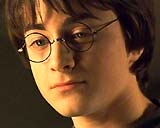 Harry Potter (Daniel Radcliffe) 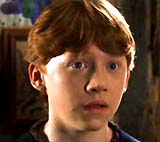 Ron Weasley (Rupert Grint) 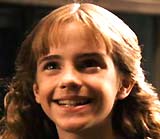 Hermione Granger (Emma Watson) 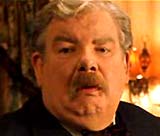 Uncle Vernon Dursley (Richard Griffiths) 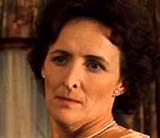 Aunt Petunia Dursley (Fiona Shaw) 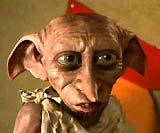 House-Elf Dobby (Voice of Toby Jones) 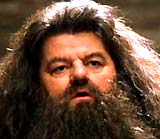 Rubeus Hagrid (Robbie Coltrane) 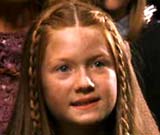 Ginny Weasley (Bonnie Wright) 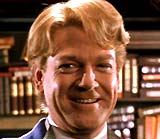 Professor Gilderoy Lockhart (Kenneth Branagh) 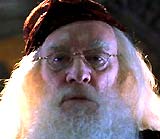 Professor Albus Dumdledore (Richard Harris) 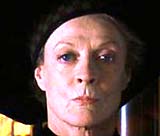 Minerva McGonagall (Maggie Smith) 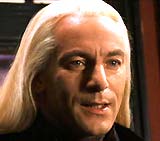 Lucius Malfoy (Jason Isaacs) 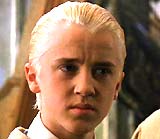 Draco Malfoy (Tom Felton) 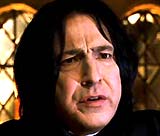 Professor Severus Snape (Alan Rickman) 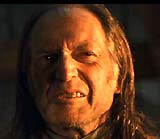 Argus Filch (David Bradley) 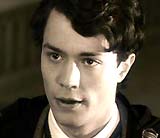 Tom Marvolo Riddle (Christian Coulson) 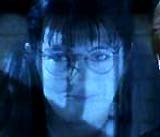 Moaning Myrtle (Shirley Henderson) 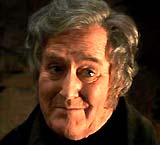 Cornelius Fudge (Robert Hardy) |
| Harry Potter and The Sorcerer's Stone (2001) Film Plot Summary 11 year-old orphaned Harry Potter (Daniel Radcliffe), with a lightning bolt-shaped scar on his forehead after being touched by a curse, lived a miserable life with his Muggle ("non magic folk") relatives: Aunt Petunia Dursley (Fiona Shaw) and Uncle Vernon Dursley (Richard Griffiths), after the darkly evil/cruel wizard Lord Voldemort (Richard Bremmer) killed his parents James and Lily Potter when he was one year old. He learned the truth of his life (that his parents weren't killed in a car crash) from long-haired, bearded half-giant Rubeus Hagrid (Robbie Coltrane) - the groundskeeper from Hogwarts School, and was surprised to know he was famous: "You're the boy who lived"; he was enrolled as a student at a wizards boarding school called Hogwarts School of Witchcraft and Wizardry, run by powerful Headmaster Albus Dumbledore (Richard Harris) and his strict Deputy Headmistress Minerva McGonagall (Maggie Smith), who could morph into a cat. Harry took the express train to Hogwarts from Platform 9 3/4ths at King's Cross Station in London; he quickly made friends with red-haired student Ron Weasley (Rupert Grint) and intelligent student-witch Hermione Granger (Emma Watson), who lived with him at Gryffindor House on the campus, in competition with the Slytherin House, run by devious potions master Professor Severus Snape (Alan Rickman) (revealed to be helping Voldemort). The trio soon learned more about the mystery of Harry's parents' deaths -- a disembodied, cursed Voldemort, after trying to kill Harry years earlier, was plotting a comeback by taking a philosopher's stone (made by 665 year-old Nicholas Flamel, the only known maker of the Sorcerer's Stone: "It'll transform any metal into pure gold, and produces the Elixir of Life which will make the drinker immortal"), hidden in a chamber under a trap door at Hogwarts that was guarded by a fierce 3-headed dog named Fluffy. The film's climax found the trio seeking the stone, and Harry discovering the Mirror of Erised (that reflected "the deepest and most desperate desires of the heart") which showed him his dead parents; when they were confronted by Voldemort (who parasitically possessed the body of turbaned Professor Quirrell (Ian Hart) and talked from the back of his head), Harry's magical powers prevented Voldemort from stealing the stone and defeating him with lethal spells; Dumbledore also helped to save the hero Harry, and the stone was destroyed. The film ended with a victory of Gryffindor House against Slytherin for the House Cup when extra points were awarded to them. The film contained many fanciful elements, such as owl-postal delivery, Gringotts' bank goblins, a Sorting Hat (to determine housing at Hogwarts), a fully-grown Mountain Troll that menaced Hermione in the girl's bathroom, an Invisibility Cloak, a young Norwegian Ridgeback dragon that spewed fire named Norbert, a forbidden Dark Forest with an injured unicorn and a centaur named Firenze, regular and life-sized games of chess, a game called Quidditch with players zooming around on broomsticks to catch a winged Golden Snitch, and changing banquet hall decorations. Film Notables (Awards, Facts, etc.) All of the films in this incredible fantasy/adventure film series were based upon adaptations of the J. K. Rowling books. Based upon Rowling's 1997 novel Harry Potter and the Philosopher's Stone. With a production budget of $125 million, its box-office was immense, $318 million (domestic) and $975 million (worldwide), and the highest grossing film of 2001, and the highest grossing film of the series - to date. With three Academy Award nominations: Best Art Direction, Best Costume Design, and Best Original Score, with no wins. Some religious controversy surrounded the film in regards to its celebration of witchcraft and magic. | 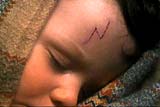 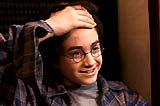 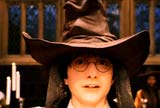  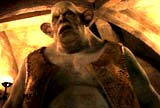 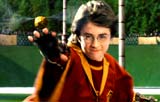 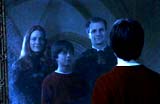  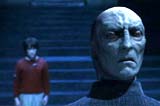 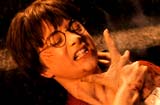 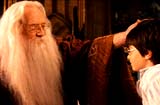 |
Greatest Movie Series
Franchises of All Time
The Harry Potter Films
Harry Potter and the Sorcerer's Stone (2001)
Harry Potter and the Chamber of Secrets (2002)
Harry Potter and the Prisoner of Azkaban (2004)
Harry Potter and the Goblet of Fire (2005)
Harry Potter and the Order of the Phoenix (2007)
Harry Potter and the Half-Blood Prince (2009)

Best known for his scriptwork on the last two Batman movies and the Blade Trilogy -- has stuffed The Unborn with one horror movie cliché after another, making it one of the most generic flicks I've seen in recent years. It also reminds me of Kurt Vonnegut's definition of a blivit: two pounds of shit in a one pound bag. The clichés include a pale, revenant child (The Grudge, The Ring, A Tale of Two Sisters, or insert your favorite J-Horror film here); a dead twin (The Other); a gratuitous insect attack; long-hidden, grainy film footage; the use of mirrors as spiritual doorways (Mirrors, Prince of Darkness); obvious dream sequences, including one to open the film, naturally; head-twisting right out of The Exorcist, not once but twice; a spunky female lead who walks around in her underwear a lot (okay, I'm not really complaining about that part); cute friends who make convenient victims; long-held secrets that drive people crazy; and so forth. You could still make a good movie out of that tapestry, but it takes more than what we have here. The Unborn understands the notes, but it doesn't hear the music.
The plot goes like this: Casey Beldon (played by Odette Yustman, a Megan Fox-look-alike who can be seen in Cloverfield, another turkey), is a Chicago University student whose mother (Carla Gugino) committed suicide years earlier. Casey today is suffering from visions of a) a spooky little kid who keeps popping up out of nowhere, and b) her mother's death in a psycho ward. A trip to the doctor shows that one of Casey's eyes appears to be changing colour, and this leads to the revelation that she had a twin who died in utero, posthumously named Jumby. (Now seriously, what numbnuts would name their child Jumby? The parents probably figured that, since he was already dead, he wouldn't have to worry about being beaten to a pulp on the playground.) After a quick trip to her attic and some detective work, Casey discovers that the crazy old woman she met in a rest home is actually her grandma Sofi (Jane Alexander), a Holocaust survivor, and that our re-appearing ghost-boy is Casey's great uncle Barto. It seems that following his death at the hands of Auschwitz doctors, Barto's body was possessed by a dybbuk, a Jewish demon looking to get into our world by taking over the body of a twin -- although, as we're schooled later, apparently anyone's body will do in a pinch. Sofi defeated its first attempt in Auschwitz, but now it's using the spirit of Casey's dead twin to enter our world once again. Casey decides her only hope is a Jewish exorcism, performed by Rabbi Sendak (Gary Oldman). You can imagine how well that's going to turn out.
Despite having worked on several hit screenplays, Goyer still has a tin ear for dialogue. Witness, for instance, the line where Sofi tells her granddaughter that she'll have to slay the demon herself: "It has fallen on you to finish what began in Auschwitz." Did nobody tell Goyer just how wrong that sounded? Or is it that the current generation in Hollywood is so historically ignorant that it never occurred to anyone? At least Goyer's script is clever enough to name the rabbi after the author of Where the Wild Things Are. But it's cluttered with so much unnecessary material that one never feels a sense of the imagination at work. It's just labored and clunky, poorly paced and convoluted.
It's also heavily dependent upon the horror movie staple technique of the jump scare. Even a child can pull this off: you just wait until your friend is passing by unawares and yell "Boo!" Pretty simple, right? And it used to work pretty well, when I was eight. Good horror flicks use it a couple of times, tops; The Unborn returns to that well again and again.
The movie looks terrific, even if that same look is as much a cliché as the rest of the movie. Cinematographer Jim Hawkinson (who also shot The Hitcher in 2007) creates a solid image, but one with the computer-assisted desaturation that has become the standard go-to "look" for horror movies today. Push the button on your console marked "Horror," and your movie can also look like Underworld, Se7en, Saw, Eden Lake, Autopsy, The Ring, The Orphanage, Mirrors, The Eye, Wrong Turn, Frontier(s), High Tension, Pulse, Vacancy, The Broken, and on and on. But at least the skin tones look fine.
If I'm going to praise one thing about this movie, it's the choice to make Ms. Yustman's scantily clad derrière the focus of the final poster. That was near genius. Call it exploitation if you like (and you would be correct), but it's the movie's real star turn.
(The disc, in both its DVD and Blu-Ray incarnations, is available with the unrated version included, which is only one lousy minute longer than the theatrical release. I don't consider this to be a bonus. The only extra the disc has is a useless collection of deleted scenes. You're better off skipping it.)

The Collected Stories of Robert Silverberg, Vol. 4: Trips 1972-73
Posted by Manzoor in Science Fiction Book Reviews
 Robert Silverberg's Trips offers a rather strange and perhaps skewed look at his writing. Covering two years at the beginning of the 70s, when the New Wave was still aiming for relevancy and the "old guard" was trying to find its place in the brave new world created by the New Wave authors, Silverberg found himself writing against his own style, often, as he explains in his introductions, producing efforts which didn't quite feel right to him.
Robert Silverberg's Trips offers a rather strange and perhaps skewed look at his writing. Covering two years at the beginning of the 70s, when the New Wave was still aiming for relevancy and the "old guard" was trying to find its place in the brave new world created by the New Wave authors, Silverberg found himself writing against his own style, often, as he explains in his introductions, producing efforts which didn't quite feel right to him. However, while some of the stories in Trips don't stand up to the test of time, many of them do. "Born with the Dead," which went on to win a Nebula Award for Silverberg, is perhaps the most successful of the stories included, but others, such as the titular "Trips" or "The Dybbuk of Mazel Tov IV" stand the test of time. These stories show that no matter how much Silverberg was feeling that times were changing around him, he could still tell a good story.
Silverberg portrays the period as a time of rampant narrative experimentation, and his stories do demonstrate the sort of thing that was happening. "Breckenridge and the Continuum," for instance, is a less than successful trying to be too many things and almost consciously trying to set itself apart from the other stories in Silverberg's canon.
Generally, Silverberg's concerns about his writing are less in evidence within the text of his stories, and only come to light in the introductions which in some ways give a better indication of the times than the stories themselves. In these pieces, Silverberg talks about personal issues he was having and relates them to the way the world was changing in the early 70s. They provide a context for the stories which can stand on their own, but which are stronger for having a background against which to read them.
While the introductions add quite a bit to the collection, the strength is in the stories, nearly all of which, even when Silverberg is at his most experimental, manage to stand up to the passage of nearly four decades. The few stories that show their age, like the anthropological tale "Schwartz Between the Galaxies," can be seen as indicative of the period in which they were written. They remind the reader that all authors can have weak outings, perhaps especially when trying to shoehorn themselves into a newer style of writing than they are used to.
For the most part, Trips is a good introduction to Silverberg's writing. There are a few very strong pieces and a few which haven't aged well, most of the stories demonstrate Silverberg's creative quality and show a journeyman's ability to both entertain and make the reader think about the situation he has proposed.

After the events portrayed in The Dreaming Void, the Void has suddenly grown even faster than before. At the same time, members of the Living Dream have started a mass migration, hoping to lead them to a new home in the Void. The government of the human Commonwealth and others who see the Void as a danger are out to stop them, and prevent the Void from swallowing our universe from within.
That part of the story fits pretty comfortably into the standard part two of a trilogy scenario. Like The Dreaming Void, The Temporal Void alternates between action and intrigue in our universe and the story of Edeard, also known as the Waterwalker, in the Void. It's in Edeard's story that the details of life in the Void, what it means for the humans who already live there, its relationship to our universe, and the exact nature of the threat it poses to our universe begin to emerge. If the emphasis in The Dreaming Void was how the existence of the Void was affecting life in our universe, by the end of The Temporal Void the focus has turned to the Void, where the story of Edeard's life has slowly but surely become the key to determining how the Void works, and why.
Readers and fans of Peter F. Hamilton will find everything they have come to expect from his work present in The Temporal Void. There are the high-tech civilizations, this is, after all, a space-opera, and the individuals they empower. There are insider schemes and outsiders desperately trying to figure out what's going on. There is also the author's seeming fascination with life after death, all of it wrapped up in a story that places as much emphasis on characters as it does gadgets and galaxy-threatening, life-changing events.
There are also a few weaknesses evident. As Edeard's story becomes more central to the plot, less time is spent on other characters, and there are times when it almost seems a sub-plot or two has disappeared from the story. And life in the Commonwealth, for all its high-tech marvels, often comes across as living in one big intergalactic suburb. Those faults, though, hardly get in the way of what continues to be a gripping story, with the fates of two universes at stake, and characters whose lives are completely caught up in what is the central mystery of the universe they inhabit. Peter F. Hamilton is not a writer who is out to re-invent the field or tell his story in a way that has never been done before, but he is a writer more than capable of taking the basic elements of wide-ranging, galaxy-spanning space opera, and using them to tell stories that work both as adventure tales and portrayals of an interesting and diverse set of characters. Now all that's left is to find out how the story ends.
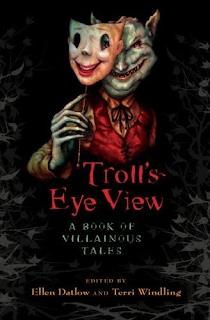
In this new collection of short stories from acclaimed anthologists Ellen Datlow and Terri Windling, fifteen of the field's best fantasy authors tackle the subject of fairy tales, retold from the viewpoint of the villain, and aimed at a younger audience. In these stories, they explore things from a new perspective. Are fairy tale antagonists really evil, or just misunderstood? Are they sympathetic, or do they deserve their dire fates? And who really does live happily ever after? Some of those answers may just be found in this book.
Delia Sherman examines the role of the evil wizard, in "Wizard's Apprentice," in which a young man chooses the life of an apprentice rather than go on with an undesirable home life. What he learns may just surprise him.
Garth Nix completely reverses the line between good and evil with his retelling of Rapunzel. In "An Unwelcome Guest," it's Rapunzel who's forcing her presence upon a rather unhappy witch, and only a clever reinterpretation of the rules will get rid of this undesirable house guest.
Nina Kiriki Hoffman opts for a more straight-forward retelling of The Goose Girl, but from the viewpoint of the unfaithful maidservant. In "Rags and Riches," we're shown just how and why that maidservant chose to become a princess, and how her choices affected her. It's a subtle bending of the old story, but intriguing nonetheless, especially with its hints for a wide-open future for the protagonist.
In "Up The Down Beanstalk: A Wife Remembers," Peter S. Beagle suggests that the thing with Jack and the giant and the goose that laid the golden eggs may have been blown out of proportion and subject to misunderstanding. The end result is something far less dramatic, but far more humanizing.
Ellen Kushner's "The Shoes That Were Danced To Pieces" is an elegant, low-key retelling of the Twelve Dancing Princesses. In the absence of a true villain for that story, it twists one small but vital aspect of the tale to take on the topic of responsibility and maturity, leading to a satisfying conclusion.
Holly Black's offering, "The Boy Who Cried Wolf" is a rather chilling little piece, about a young man who knows too much for his own good, and who makes a tragic choice in the interests of doing the right thing. This is one of those stories where bad things happen to good people, not the comforting sort at all.
Jane Yolen's "Troll" looks at the story about the three goats and the bridge from what else, the viewpoint of the troll. Short and sweet, it shows that sometimes, all the villain wants is a nice, tasty, cooked meal.
Nancy Farmer juxtaposes history, literature, and fairy tales with her story of "Castle Othello," which merges Bluebeard and Othello and adding an interesting twist to their combined history. The result is both wry and respectful, making for an intriguing story all around.
In all of the fairy tale world, few villains have ever been as universally abused and cheated as poor Rumplestiltskin, who made a fair deal by his own standards and was then undone by his client's case of buyer's remorse. Well, in Michael Cadnum's "'Skin," we're treated to a far different interpretation of said tale, where the baby-desiring nature of the titular spinner-of-gold are explored and put into a new light. Is he a villain for having certain culinary desires, or just a gourmand? And is the miller's daughter so sympathetic after all? It's an interestingly warped retelling, all in all.
Catherynne M. Valente revisits the witch of Hansel and Gretel, telling her unusual story and unique origins in "A Delicate Architecture." It's a beautiful, haunting, strange piece that explores what sort of woman would live in a gingerbread house in the woods. With a little bit of The Gingerbread Man tossed in for good measure (or so it seems) it's thoughtful and poetic, told with Valente's usual attention to detail and imagery.
In "Molly," by Midori Snyder, a different story of clever humans versus giants is uprooted and retold. And once again, the so-called villains are the sympathetic parties, minding their own business until a mean-spirited 'hero' comes along to torment them. Poignant and provocative, it summons up the image of unjustly-persecuted minorities just as much as it does fairy tale monsters.
Kelly Link looks at the nature of being a villain, focused through the lens of step-sibling rivalry in "The Cinderella Game." This is another one of those stories where things are more than a little disturbing, and you're not sure who to root for... if anyone. Frankly, this is the perfect setup for one of those horror stories featuring naughty, evil children who come to bad ends.
Neil Gaiman's poem, "Observing the Formalities," takes a new look at Sleeping Beauty from the viewpoint of the "bad" fairy. Joseph Stanton's poem "Puss in Boots, The Sequel" adds a new spin to that particular tale, and "Faery Tales" by Wendy Froud is a poetic speculation on what happens to some of those who live happily ever after.
Not one of these stories is anything less than excellent. They certainly fulfill the mandate of retelling and reexamining fairy tales from the perspective of the traditional villain. Evil witches, trolls, bad fairies, giants and more get their day in the sun, and as you can see, it's not even as simple as every story making them come out as the true heroes. There's a subtle complexity, a questioning of traditional fairy tale morals, a subversion of the familiar, and taken as a whole, it gets the point across without overdoing it. So in that regard, Troll's-Eye View is a splendid anthology. My only gripe is that the stories are too short. Many of them end just as they get good, or leave the reader wanting more about those characters or set in that world. There's so much room for expansion and further exploration that it's a disappointment to have the story over with so quickly. And when my only complaint is that I didn't get enough, that's definitely a plus in my book. Of course, this anthology is aimed at somewhat younger readers, the 9-and-up crowd, so there's only so far you can go and keep it audience-friendly. Ultimately, Windling and Datlow do what they've always done: deliver a top-notch collection filled with excellent authors and perfectly-chosen stories. As always, a superb read.
Science fiction often expresses the potential of technology to destroy humankind through Armaggedon-like events, wars between worlds, Earth-imperiling encounters or disasters (i.e., The Day The Earth Stood Still (1951), When Worlds Collide (1951), The War of the Worlds (1953), the two Hollywood blockbusters Deep Impact (1998) and Armageddon (1998), and The Day After Tomorrow (2004), etc.). In many science-fiction tales, aliens, creatures, or beings (sometimes from our deep subconscious, sometimes in space or in other dimensions) are unearthed and take the mythical fight to new metaphoric dimensions or planes, depicting an eternal struggle or battle (good vs. evil) that is played out by recognizable archetypes and warriors (i.e., Forbidden Planet (1956) with references to the 'id monster' from Shakespeare's The Tempest, the space opera ![]() Star Wars (1977) with knights and a princess with her galaxy's kingdom to save, The Fifth Element (1997), and the metaphysical Solaris (1972 and 2002)). Beginning in the 80s, science fiction began to be feverishly populated by noirish, cyberpunk films, with characters including cyber-warriors, hackers, virtual reality dreamers and druggies, and underworld low-lifers in nightmarish, un-real worlds (i.e.,
Star Wars (1977) with knights and a princess with her galaxy's kingdom to save, The Fifth Element (1997), and the metaphysical Solaris (1972 and 2002)). Beginning in the 80s, science fiction began to be feverishly populated by noirish, cyberpunk films, with characters including cyber-warriors, hackers, virtual reality dreamers and druggies, and underworld low-lifers in nightmarish, un-real worlds (i.e., ![]() Blade Runner (1982), Strange Days (1995), Johnny Mnemonic (1995), and The Matrix (1999)).
Blade Runner (1982), Strange Days (1995), Johnny Mnemonic (1995), and The Matrix (1999)).
Borrowing and Hybrid Genre Blending in Sci-Fi Films:
The genre is predominantly a version of fantasy films (![]() Star Wars (1977)), but can easily overlap with horror films, particularly when technology or alien life forms become malevolent (Alien (1979)) in a confined spaceship (much like a haunted-house story). Quite a few science-fiction films took an Earth-bound tale and transported it to outer space:
Star Wars (1977)), but can easily overlap with horror films, particularly when technology or alien life forms become malevolent (Alien (1979)) in a confined spaceship (much like a haunted-house story). Quite a few science-fiction films took an Earth-bound tale and transported it to outer space: ![]() High Noon (1952) became Outland (1980), The Magnificent Seven (1960) was spoofed in Battle Beyond the Stars (1980), Enemy Mine (1985) was essentially a remake of Hell in the Pacific (1968) with Lee Marvin and Toshiro Mifune, and the chariot race of
High Noon (1952) became Outland (1980), The Magnificent Seven (1960) was spoofed in Battle Beyond the Stars (1980), Enemy Mine (1985) was essentially a remake of Hell in the Pacific (1968) with Lee Marvin and Toshiro Mifune, and the chariot race of ![]() Ben-Hur (1959) was duplicated in the pod-race of Star Wars: Episode I - The Phantom Menace (1999).
Ben-Hur (1959) was duplicated in the pod-race of Star Wars: Episode I - The Phantom Menace (1999).
Further, there are many examples of blurred or hybrid science fiction films that shared characteristics with lots of other genres including:
- westerns (Outland (1980))
- romances (Somewhere in Time (1980))
- adventure films (The Thing From Another World (1951))
- action films (Terminator 2 - Judgment Day (1991))
- comedies (Sleeper (1973))
- serials (
 Star Wars (1977))
Star Wars (1977)) - cop-buddy films (Alien Nation (1988))
The Earliest Science Fiction Films:
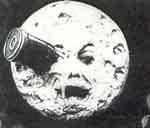 Many early films in this genre featured similar fanciful special effects and thrilled early audiences. The pioneering science fiction film, a 14-minute ground-breaking masterpiece with 30 separate tableaus (scenes), Le Voyage Dans La Lune (A Trip to the Moon) (1902), was made by imaginative, turn-of-the-century French filmmaker/magician Georges Melies, approximating the contents of the novels by Jules Verne (From the Earth to the Moon) and H.G. Wells (First Men in the Moon). With innovative, illusionary cinematic techniques (trick photography with superimposed images, dissolves and cuts), he depicted many memorable, whimsical old-fashioned images:
Many early films in this genre featured similar fanciful special effects and thrilled early audiences. The pioneering science fiction film, a 14-minute ground-breaking masterpiece with 30 separate tableaus (scenes), Le Voyage Dans La Lune (A Trip to the Moon) (1902), was made by imaginative, turn-of-the-century French filmmaker/magician Georges Melies, approximating the contents of the novels by Jules Verne (From the Earth to the Moon) and H.G. Wells (First Men in the Moon). With innovative, illusionary cinematic techniques (trick photography with superimposed images, dissolves and cuts), he depicted many memorable, whimsical old-fashioned images:
- a modern-looking, projectile-style rocket ship blasting off into space from a rocket-launching cannon (gunpowder powered?)
- a crash landing into the eye of the winking 'man in the moon'
- the appearance of fantastic moon inhabitants (Selenites, acrobats from the Folies Bergere) on the lunar surface
- a scene in the court of the moon king
- a last minute escape back to Earth
Otto Rippert's melodramatic and expressionistic Homunculus (1916, Ger.) - mostly a lost silent film - was a serial (or mini-series) composed of six one-hour episodic parts. It told about the life of an artificial man (Danish actor Olaf Fonss) that was created by an archetypal mad scientist (Friedrich Kuhne). The monstrous, vengeful creature, after realizing it was soul-less and lacked human emotion, became a tyrannical dictator but was eventually destroyed by a divine bolt of lightning. Its importance as an early science-fiction film was that it served as a precursor and inspiration to Universal's Frankenstein (1931) film and many other plots of sci-fi films (with mad scientists, superhuman androids, Gothic elements, and the evil effects of technology).
 The first science fiction feature films appeared in the 1920s after the Great War, showing increasing doubts about the destructive effects of technology gone mad. The first feature-length dinosaur-oriented science-fiction film to be released was The Lost World (1925). It was also the first feature length film made in the US with the pioneering first major use (primitive) of stop-motion animation with models for its special effects. It helped to establish its genre - 'live' and life-like giant monsters-dinosaurs, later replicated in Gojira (1954, Jp.), Jurassic Park (1993) and Godzilla (1998).
The first science fiction feature films appeared in the 1920s after the Great War, showing increasing doubts about the destructive effects of technology gone mad. The first feature-length dinosaur-oriented science-fiction film to be released was The Lost World (1925). It was also the first feature length film made in the US with the pioneering first major use (primitive) of stop-motion animation with models for its special effects. It helped to establish its genre - 'live' and life-like giant monsters-dinosaurs, later replicated in Gojira (1954, Jp.), Jurassic Park (1993) and Godzilla (1998).
One of the greatest and most innovative films ever made was a silent film set in the year 2000, German director Fritz Lang's classic, expressionistic, techno-fantasy masterpiece Metropolis (1927) - sometimes considered the ![]() Blade Runner of its time. It featured an evil scientist/magician named Rotwang, a socially-controlled futuristic city, a beautiful but sinister female robot named Maria (probably the first robot in a feature film, and later providing the inspiration for George Lucas' C3-PO in
Blade Runner of its time. It featured an evil scientist/magician named Rotwang, a socially-controlled futuristic city, a beautiful but sinister female robot named Maria (probably the first robot in a feature film, and later providing the inspiration for George Lucas' C3-PO in ![]() Star Wars), a stratified society, and an oppressed enslaved race of underground industrial workers. Even today, the film is acclaimed for its original, futuristic sets, mechanized society themes and a gigantic subterranean flood - it appeared to accurately project the nature of society in the year 2000. [It was re-released in 1984 with a stirring, hard-rock score featuring Giorgio Moroder's music and songs by Pat Benatar and Queen.]
Star Wars), a stratified society, and an oppressed enslaved race of underground industrial workers. Even today, the film is acclaimed for its original, futuristic sets, mechanized society themes and a gigantic subterranean flood - it appeared to accurately project the nature of society in the year 2000. [It was re-released in 1984 with a stirring, hard-rock score featuring Giorgio Moroder's music and songs by Pat Benatar and Queen.]
Another Lang film, his last silent film, was one of the first space travel films, The Woman in the Moon (1929) (aka By Rocket to the Moon). It was about a blastoff to the moon where explorers discovered a mountainous landscape littered with raw diamonds and chunks of gold. [The film introduced NASA's backward count to a launch - 5-4-3-2-1 to future real-life space shots, and the effects of centrifugal force to future space travel films.]
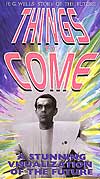 Alexander Korda's epic view of the future Things to Come (1936) was directed by visual imagist William Cameron Menzies and starred Raymond Massey (as pacifist pilot John Cabal). The imaginative English film was based on an adaptation of H. G. Wells' 1933 The Shape of Things to Come and set during the years from 1940 to 2036 in 'Everytown.' It included a lengthy global world war (WW II!), a prophetic Brave New World-view, a despotic tyrant named Rudolph (Ralph Richardson), the dawn of the space age, and the attempt of social-engineering scientists to save the world with technology. An attempt to prevent scientific progress - and the launch of the first Moon rocket - was vainly led by sculptor Theotocopulos (Cedric Hardwicke). David Butler's Just Imagine (1930), a futuristic sci-fi musical about a man who awakened in a strange new world - New York City in the 1980s, provided prophetic inventions including automatic doors, test tube babies, and videophones.
Alexander Korda's epic view of the future Things to Come (1936) was directed by visual imagist William Cameron Menzies and starred Raymond Massey (as pacifist pilot John Cabal). The imaginative English film was based on an adaptation of H. G. Wells' 1933 The Shape of Things to Come and set during the years from 1940 to 2036 in 'Everytown.' It included a lengthy global world war (WW II!), a prophetic Brave New World-view, a despotic tyrant named Rudolph (Ralph Richardson), the dawn of the space age, and the attempt of social-engineering scientists to save the world with technology. An attempt to prevent scientific progress - and the launch of the first Moon rocket - was vainly led by sculptor Theotocopulos (Cedric Hardwicke). David Butler's Just Imagine (1930), a futuristic sci-fi musical about a man who awakened in a strange new world - New York City in the 1980s, provided prophetic inventions including automatic doors, test tube babies, and videophones.
Early Science-Fiction - Horror Film Blends: The 30s
The most memorable blending of science fiction and horror was in Universal Studios' mad scientist-doctor/monster masterpiece from director James Whale, Frankenstein (1931), an adaptation of Mary Shelley's novel. Her original 1818 book was subtitled Frankenstein - The Modern Prometheus, and she used this allusion to signify that her main character Dr. Victor Frankenstein demonstrated 'hubris' against god/nature in his experimental desire to create life from dead body parts, and afterwards abandoned his monstrous ugly creature. 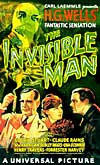 Like the Titan god, who stole fire from the gods to benefit mankind, he did not realize the ramifications of his actions. (Although there were civilizing results of having fire, it also brought the ability to work with metals, which could be shaped into weapons, that could then be used in warfare.) Many other derivative works, including numerous sci-fi films, have featured mad scientists, and artificially-created monsters that run amok killing people.
Like the Titan god, who stole fire from the gods to benefit mankind, he did not realize the ramifications of his actions. (Although there were civilizing results of having fire, it also brought the ability to work with metals, which could be shaped into weapons, that could then be used in warfare.) Many other derivative works, including numerous sci-fi films, have featured mad scientists, and artificially-created monsters that run amok killing people.
This was soon followed by Whale's superior sequel ![]() Bride of Frankenstein (1935), one of the best examples of the horror-SF crossover, and one of the first films with a mad scientist's creation of miniaturized human beings. The famed director also made the film version of an H. G. Wells novel The Invisible Man (1933) with Claude Rains (in his film debut in the starring title role) - it was the classic tale of a scientist with a formula for invisibility accompanied by spectacular special effects and photographic tricks.
Bride of Frankenstein (1935), one of the best examples of the horror-SF crossover, and one of the first films with a mad scientist's creation of miniaturized human beings. The famed director also made the film version of an H. G. Wells novel The Invisible Man (1933) with Claude Rains (in his film debut in the starring title role) - it was the classic tale of a scientist with a formula for invisibility accompanied by spectacular special effects and photographic tricks.
Mad Scientists in Early Horror/Sci-Fi Films:
In the 1930s and early 40s, American sound films with hybrid science fiction/horror themes included an oddball collection of mad scientist films, with memorable characters who created mutated or shrunken creatures:
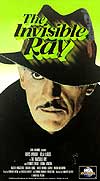 The Vampire Bat (1932) - a low-budget Majestic Pictures film in which Lionel Atwill starred as mad doctor Otto Von Niemann, responsible for creating bloodsucking nocturnal bats in a small German town; with a cast including dark-haired, 'scream-queen' Fay Wray, Melvyn Douglas, and Dwight Frye (the crazy Renfield character in Dracula)
The Vampire Bat (1932) - a low-budget Majestic Pictures film in which Lionel Atwill starred as mad doctor Otto Von Niemann, responsible for creating bloodsucking nocturnal bats in a small German town; with a cast including dark-haired, 'scream-queen' Fay Wray, Melvyn Douglas, and Dwight Frye (the crazy Renfield character in Dracula)- Doctor X (1932), a First National (later Warner Bros.) film, in pioneering two-strip Technicolor by director Michael Curtiz, about another mysterious mad scientist named Doctor X-avier (Lionel Atwill) and his daughter (Fay Wray)
- The Mystery of the Wax Museum (1933), another First National film in two-strip Technicolor, about an insane, wax-dummy maker-sculptor, again pairing Atwill and Wray, and featuring Glenda Farrell as a fast-talking, wisecracking reporter; famous for the shocking 'face-mask crumbling' scene; [re-made in 1953 as House of Wax with Vincent Price]
- The Black Cat (1934) - the first and best of all the Karloff-Lugosi pairings at Universal, featuring Boris Karloff (as a crazed devil worshipper) and Bela Lugosi (as a vengeful architect)
- The Invisible Ray (1936) - although he usually played a grotesque monster, Karloff starred as experimental physicist Dr. Janos Rukh in this film; after traveling to Africa with his colleague Dr. Benet (Bela Lugosi) and becoming infected by radiation (Radium X) in a meteor of the nebula Andromeda, Karloff was transformed into a murdering, radiation-poisoned megalomaniac as he hunted down his enemies and projected death rays at them from his eyes (glaring from under a soft felt hat)
 Tod Browning's off-beat The Devil Doll (1936) - with Devil's Island escapee and scientist Paul Lavond (Lionel Barrymore), disguised as a macabre elderly woman ("Madame Mandelip"), vengefully terrorizing his enemies by creating shrunken "devil dolls" to seek out his revenge; with landmark special effects, and Maureen O'Sullivan in a supporting role as Lavond's daughter
Tod Browning's off-beat The Devil Doll (1936) - with Devil's Island escapee and scientist Paul Lavond (Lionel Barrymore), disguised as a macabre elderly woman ("Madame Mandelip"), vengefully terrorizing his enemies by creating shrunken "devil dolls" to seek out his revenge; with landmark special effects, and Maureen O'Sullivan in a supporting role as Lavond's daughter - Ernest Schoedsack's and Paramount's Dr. Cyclops (1940) - the first Technicolor horror/sci-fi film since The Mystery of the Wax Museum (1933), with Albert Dekker as sadistic, bald, bespectacled mad scientist Dr. Thorkel shrinking his victims in a remote Peruvian jungle setting; the film received an Academy Award nomination for its Visual Effects
- The Monster and the Girl (1941) - another Paramount "B" horror/sci-fi film from director Stuart Heisler, about eccentric mad scientist Dr. Parry (George Zucco) who transplanted the brain of a wrongly-accused and executed murderer into a murderous gorilla, who then went on a rampage to seek revenge
- director George Sherman's The Lady and the Monster (1944) - the first film version of the classic tale Donovan's Brain by Curt Siodmak [remade in 1954], in which the throbbing, telepathic brain of a dead and unscrupulous industrialist/maniac named James Donovan was kept alive by enthusiastic mad scientist/Prof. Franz Mueller (Erich von Stroheim)
Escapist Serials of the 30s: Flash Gordon and Buck Rogers
In the 1930s, the most popular films were the low-budget, less-serious, space exploration tales portrayed in the popular, cliff-hanger Saturday matinee serials with the first two science-fiction heroes - Flash Gordon and Buck Rogers.
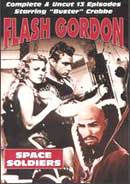 Space-explorer hero Flash Gordon was a fanciful adventure character derived from the Alex Raymond comic strip first published in 1934 (from King Features). The serials 'invented' many familiar technological marvels: anti-gravity belts, laser/ray guns, and spaceships. Universal's serialized sci-fi adventures included:
Space-explorer hero Flash Gordon was a fanciful adventure character derived from the Alex Raymond comic strip first published in 1934 (from King Features). The serials 'invented' many familiar technological marvels: anti-gravity belts, laser/ray guns, and spaceships. Universal's serialized sci-fi adventures included:
- Flash Gordon: Space Soldiers (1936), the original and the best of its type, with 13 chapters; later condensed into a 97-minute feature film titled Flash Gordon: Rocketship
- Flash Gordon's Trip to Mars (1938) - 15 episodes
- Flash Gordon Conquers the Universe (1940), 12 episodes, with Carol Hughes as Dale Arden
Popular elements in the swashbuckling films were the perfectly-cast, epic hero athlete/actor Larry "Buster" Crabbe, the lovely heroine and Flash's blonde sweetheart Dale Arden (Jean Rogers), Dr. Hans Zarkov (Frank Shannon), and the malevolent, tyrant Emperor Ming the Merciless (Charles Middleton) on far-off planet Mongo. The Flash Gordon films were remade in 1980 (with Sam J. Jones as the title character and Max von Sydow as Ming, with music by Queen), and in 1997 as the animated Flash Gordon: Marooned on Mongo. [There was also a pornographic knock-off film titled Flesh Gordon (1972) that featured a dildo-shaped spaceship.]
Wavy-haired, muscular Buster Crabbe also starred in the 12-part serial Buck Rogers Conquers the Universe (1939) shot between Flash Gordon's Trip to Mars (1938) and Flash Gordon Conquers the Universe (1940). It was derived from the novelette story "Armageddon-2419 A.D." written by Phil Nolan (published in the August 1928 issue of the pulp magazine Amazing Stories), and from the comic strip Buck Rogers in the 25th Century by Dick Calkins. In this sci-fi serial, Buck Rogers pursued the vile Killer Kane (Anthony Warde), but the series proved to be not as popular as the Flash Gordon serials.
Another serial was Republic's 15-part serial The Purple Monster Strikes (1945), aka D-Day on Mars, with one of the first instances of alien invasion. And in Columbia's 15-episode serial Bruce Gentry - Daredevil of the Skies (1949), the hero (Tom Neal) fought off the genre's first flying saucers.
Archives
-
▼
2009
(24)
-
▼
July
(14)
- The Harry Potter Films - Part 2
- The Harry Potter Films - Part 1
- The Harry Potter Films
- The Unborn
- The Collected Stories of Robert Silverberg, Vol. 4...
- The Temporal Void
- Troll's-Eye View: A Book of Villainous Tales
- Science Fiction Legacy
- Film versus literature
- Genre as commentary on social issues
- Themes, imagery, and visual elements
- History
- Definition
- Science fiction film
-
▼
July
(14)




